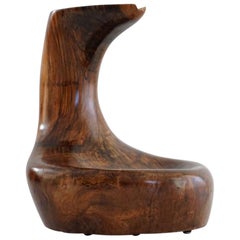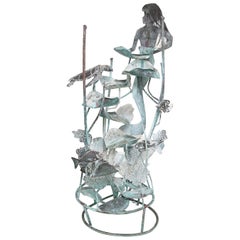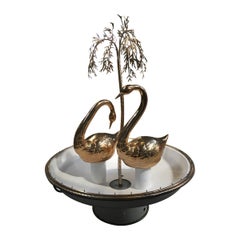Don S. Shoemaker Fountains
If it weren’t for his honeymoon, American furniture designer Don S. Shoemaker might not have played any role in Mexican modernism of the mid-20th century.
Born in Nebraska in 1919, Shoemaker studied at the School of the Art Institute of Chicago during the 1930s. In the 1940s he got married, and he and his wife, Barbara, ventured to Mexico for their honeymoon. Enamored with the country, Shoemaker decided that Mexico should become the newlyweds' permanent home. They settled in a town called Santa Maria de Guido in Michoacán, where Shoemaker spent his days painting and growing rare plants.
Through horticulture, Shoemaker became inspired by Mexico’s tropical woods, such as cocobolo, a Mexican rosewood, and he decided to delve into furniture design. In the late 1950s, he started a small factory, producing hand-carved desks, armchairs, dining room tables, decorative boxes and bowls, and serveware. The popularity of Shoemaker’s furnishings grew throughout Mexico, and his small factory became the Señal S.A. company, employing more than 100 skilled artisans and carpenters.
Shoemaker’s handcrafted designs were essentially a mid-century modern interpretation of traditional Mexican household furnishings, and like Clara Porset — an unsung Cuban-born activist, writer and designer who drew on Mexican craft traditions in her concepts for furniture — he found inspiration in his adopted country. These influences can be seen in iconic Shoemaker originals like the Sling collection of seating, the Suspension stool and several of his table designs.
Shoemaker's furniture was exhibited in showrooms in several major Mexican cities and across the U.S., including Houston, Chicago, and Los Angeles. (And mid-century modernist ideas that traveled between Mexico and California didn’t make one-way trips — they bounced back and forth.)
After Shoemaker died in 1990, his son George took over Señal S.A. The company closed after George’s death in the early 2000s.
Shoemaker’s Mexican modern furnishings continue to be coveted by avid furniture collectors around the world. From 2016 to 2017, the Museum of Modern Art in Mexico City dedicated a retrospective exhibition to honoring his work.
On 1stDibs, discover a range of vintage Don S. Shoemaker desks, seating, decorative objects and serveware.
Mid-20th Century Mexican Mid-Century Modern Don S. Shoemaker Fountains
Cocobolo
1990s North American Don S. Shoemaker Fountains
Copper
1970s Italian Mid-Century Modern Vintage Don S. Shoemaker Fountains
Metal, Brass
19th Century German Louis XV Antique Don S. Shoemaker Fountains
Ormolu
21st Century and Contemporary Modern Don S. Shoemaker Fountains
Cement
Early 1900s English Baroque Revival Antique Don S. Shoemaker Fountains
Marble
1970s American Mid-Century Modern Vintage Don S. Shoemaker Fountains
Copper
20th Century Italian Renaissance Don S. Shoemaker Fountains
Carrara Marble, Bronze
21st Century and Contemporary Modern Don S. Shoemaker Fountains
Cement
1980s American Vintage Don S. Shoemaker Fountains
Stone
Late 19th Century French Louis XV Antique Don S. Shoemaker Fountains
Marble, Bronze
19th Century French Classical Greek Antique Don S. Shoemaker Fountains
Iron
1960s European Mid-Century Modern Vintage Don S. Shoemaker Fountains
Ceramic


